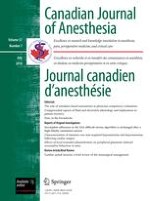Published in:

01-07-2010 | Reports of Original Investigations
Characterization of intensive care unit acquired hyponatremia and hypernatremia following cardiac surgery
Authors:
Henry Thomas Stelfox, MD, PhD, Sofia B. Ahmed, MD, David Zygun, MD, Farah Khandwala, MSc, Kevin Laupland, MD
Published in:
Canadian Journal of Anesthesia/Journal canadien d'anesthésie
|
Issue 7/2010
Login to get access
Abstract
Purpose
Although intensive care unit (ICU) acquired sodium disturbances are common in critically ill patients, few studies have examined sodium disturbances in patients following cardiac surgery. The objective of this study was to describe the epidemiology of ICU-acquired hyponatremia and hypernatremia in patients following cardiac surgery.
Methods
We identified 6,727 adults (≥18 yr) who were admitted consecutively to a regional cardiovascular intensive care unit (CVICU) from January 1, 2000 to December 31, 2006 and were documented as having normal serum sodium levels (133 to 145 mmol·L−1) during the first day of ICU admission. ICU-acquired hyponatremia and hypernatremia were defined as a change in serum sodium concentration to <133 mmol·L−1 or >145 mmol·L−1, respectively, following ICU day one.
Results
A first episode of ICU-acquired hyponatremia and hypernatremia developed in 785 (12%) and 242 (4%) patients, respectively, (95% confidence interval [CI] 11-12% and 95% CI 3-4%, respectively), with a respective incidence density of 4.2 and 1.3 patients per 100 days of ICU admission (95% CI 4.0-4.5 and 95% CI 1.2-1.5). The incidence of ICU-acquired sodium disturbances varied according to the patients’ demographic and clinical variables for both hyponatremia (age, diabetes, Acute Physiology and Chronic Health Evaluation [APACHE II] score, mechanical ventilation, length of ICU stay, serum glucose level, and serum potassium level) and hypernatremia (APACHE II score, mechanical ventilation, length of hospital stay prior to ICU admission, length of ICU stay, serum glucose level, and serum potassium level). Compared with patients with normal serum sodium levels, hospital mortality was increased in patients with ICU-acquired hyponatremia (1.6% vs 10%, respectively; P < 0.001) and ICU-acquired hypernatremia (1.6% vs 14%, respectively; P < 0.001).
Conclusion
ICU-acquired hyponatremia and hypernatremia are common complications in critically ill patients following cardiac surgery. They are associated with patient demographic and clinical characteristics and an increased risk of hospital mortality.





